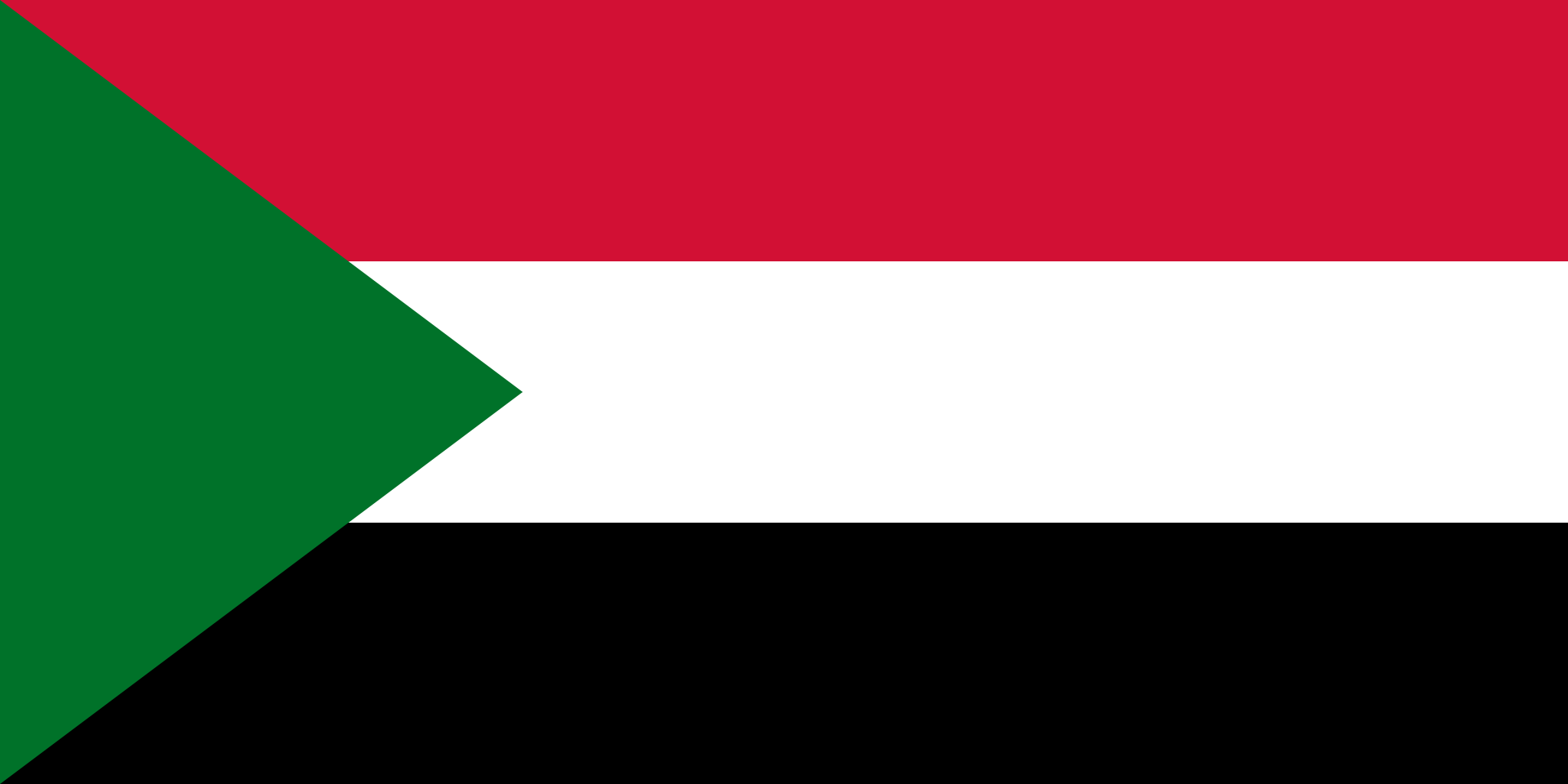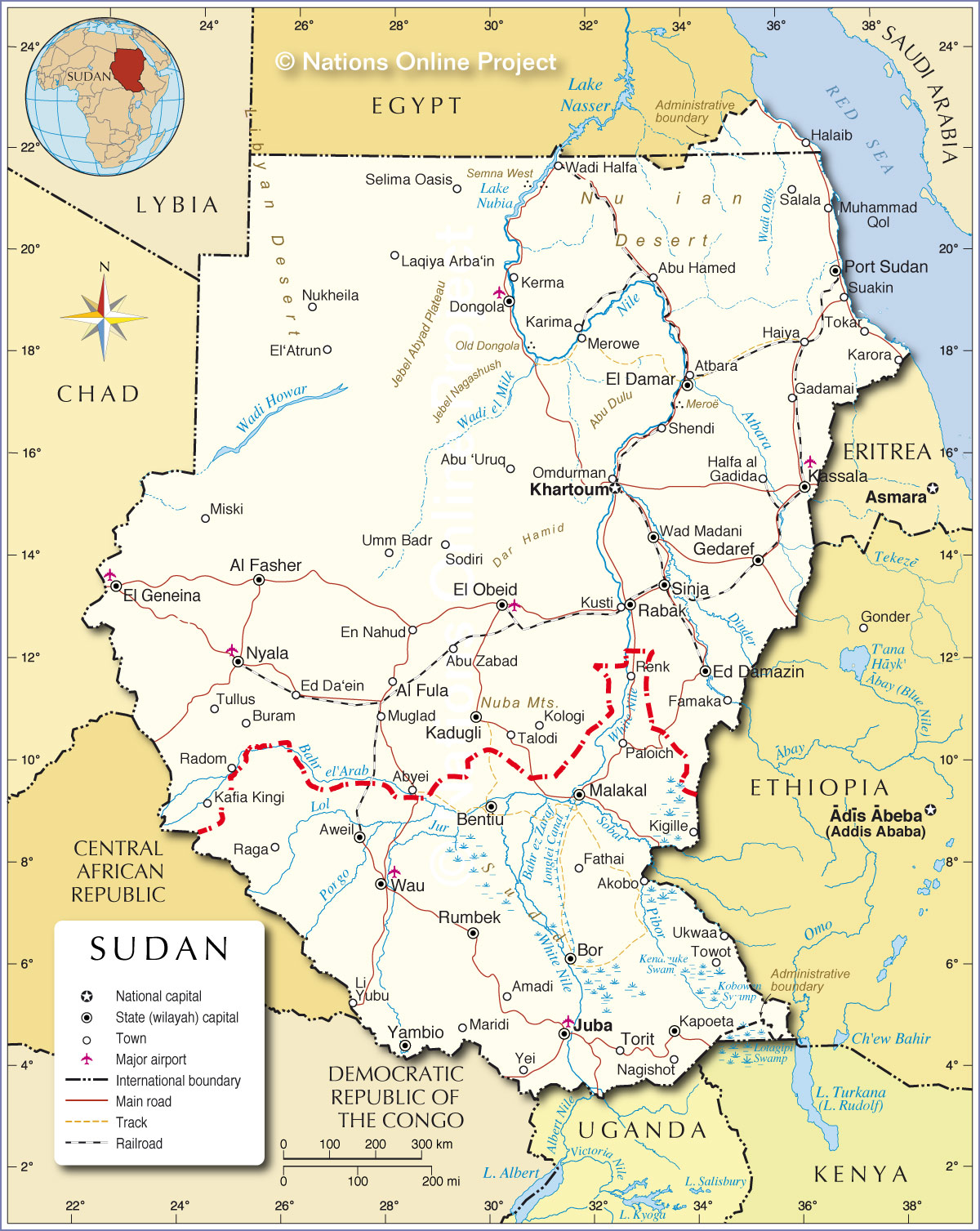Sudan and capital Khartoum have a special geopolitical location bonding the Arab world in Northern Africa to Africa south of the Sahara. It has an area of about 1.88 million km2 and is the third-largest country in Africa, after Algeria and the Democratic Republic of the Congo. Before the independence of South Sudan in 2011, it was the largest country in Africa. On the north-east Sudan is bordered by the Red Sea and it shares common borders with seven countries: Eritrea and Ethiopia in the east, South Sudan in the south, Central African Republic and Chad in the west, Libya in the northwest, and Egypt in the north.
Sudan is under the federal rule with 15 States. Each state is governed by a Wali (Governor) with 7 to 10 State Ministers, 4 to 5 Commissioners for the different provinces and several localities. Each State has complete administrative and fiscal autonomy and its own State Legislative Assembly for legislative matters of the State.
The country is generally flat with the exception of the Jebel Marra, the Red Sea Hills and the Nuba Mountains. There are three ecological zones in Sudan from north to south: the desert, the semi-desert and the low rainfall savannah. Its soils feature mainly the clay deposits in the central and eastern part, the stabilized dunes in the western and northern part, the red ironstone soils in the south, and alluvial soils along the Nile and other rivers and deltas.
Half of the country area (50.7 percent) is bare rocks and soil, such as wind-blown sands free of vegetation in hyper-arid areas. Trees cover 10 percent, shrubby vegetation 11.8 percent and herbaceous vegetation 13.8 percent. In 2012, the cultivated land was 21.25 million ha (9 percent of the total land area), comprising 21.05 million ha arable land and 0.2 million ha under permanent crops. The permanent meadows and pastures extend over 91.5 million ha and over most ecological zones: annual herbaceous plants with scattered trees and bushes dominate in the north, while perennial herbaceous plants increase southward with dense stands of woody cover. Livestock includes camels, sheep and goats, which are raised in the desert and semi-desert, and cattle that are raised in the low rainfall savannah. Almost all livestock, estimated at 107 million heads in 2009 (for the 15 northern Sudan states only; FAO and WFP, 2011), is raised under nomadic and semi-nomadic systems. The country has still diverse and fairly rich wildlife, despite losses in biodiversity (plants and fauna) since the 1970s.
Sudan Population 2020
| 44,528,803 | Current population |
| 22,435,075 | Current male population (50.4%) |
| 22,093,727 | Current female population (49.6%) |
| Species | Admin unit | Population | Units | Number of establishments | Units |
|---|---|---|---|---|---|
| Camelidae | The Whole Country | 4830000 | Animals | Establishments | |
| Cattle | The Whole Country | 30632000 | Animals | Establishments | |
| Goats | The Whole Country | 31481000 | Animals | Establishments | |
| Sheep
|
The Whole Country
|
40612000
|
Animals
|
|
Establishments
|
Agriculture
In the early 1990s, agriculture and livestock raising were the main sources of livelihood in Sudan for about 61 percent of the working population. Approximately one-third of the total area of Sudan, the largest country on the African continent is suitable for agricultural development and heavier rainfall in the south permits both agriculture and herding by nomadic tribes.
Agricultural products in total account for about 95 percent of the country’s exports. In 1998 there were an estimated 16.9 million hectares (41.8 million acres) of arable land and approximately 1.9 million hectares (4.7 million acres) set aside for irrigation, primarily in the north of the country along the banks of the Nile and other rivers. Cash crops (as of 1999) grown under irrigation in these areas include cotton and cottonseed, which is of primary importance to the economy with 172,000 tons and 131,000 tons produced annually respectively, sesame (220,000 tons), sugarcane (5,950,000 tons), peanuts (980,000 tons), dates (176,000 tons), citrus fruits, yams (136,000 tons), tomatoes (240,000 tons), mangoes, coffee, and tobacco. The main subsistence crops produced in Sudan are sorghum (3,045,000 tons), millet (1,499,000 tons), wheat (168,000 tons), cowpeas, beans, pulses, corn (65,000), and barley. Cotton is the principal export crop and an integral part of the country’s economy and Sudan is the world’s third-largest producer of sesame after India and China.
Livestock
The livestock sector plays a critical role in the Sudanese economy and the welfare of the whole population. It yields a flow of’ essential food, brings in a large amount of foreign exchange from export earnings, is a major means of transport, produces draught power in support of crop production and processing, provides dung for fertilizer and fuel and creates employment. For all these reasons and especially from the equity and livelihood perspective it is an important, indeed major, component of poverty alleviation. The value of exports from the animal sector has consistently been just under 50 percent of all agricultural exports and just under 30 percent of non-oil exports. Despite this contribution to the national economy, resource allocations for livestock and animal health services are not commensurate with the revenues generated by the sector. It is also usual for less than one-quarter of the development budget being delivered. The livestock sector employs directly or indirectly about 40 percent of the population and contributes valuable animal protein to the diets of all of Sudan’s people. To complement its already substantial comparative advantage the sector’s own foreign exchange requirements are small when compared to those needed for crop production.
Livestock is a strategic element in livelihoods, income generation, food security and agricultural development. They contribute to the national economy and human welfare and livelihoods via four principal pillars: poverty alleviation, food security, environmental conservation and gender equality.
In poverty alleviation they are often the only assets of many of the landless poor; their products (milk, meat, eggs, wool) provide a direct or indirect source of income throughout the year; they are a means of capital accumulation (livestock always appreciate but rarely depreciate) and provide a cash buffer in times of need.
In food security they are a buffer against low crop yields and crop failure and are thus an important element in risk management; produce milk and eggs that are the only agricultural products that can be harvested every day of the year; can be productive year-round where crop production is difficult or impossible; provide draught power without which crop production in many areas would be severely compromised; make use of crop and agro-industrial by-products and waste and convert them to high-quality human food.
In environmental conservation they produce manure that contributes to sustainable nutrient cycling and maintenance of soil fertility and structure; contribute to bush and weed control in many areas.
In matters of gender equality livestock, especially small animals, are often owned by women who have no access to land; women (and children) may have priority access to animal products for consumption or sale; they reduce much of the drudgery of women’s and children’s work when used for transport.
Climate
Sudan has a tropical sub-continental climate, extending from desert climate in the north through a belt of summer-rain climate to semi-dry climate. The average annual rainfall is 250 mm but ranges from 25 mm in the dry north up to 700 mm in the south. The country can be divided into two zones according to the rainfall regime:
The mean temperature ranges from 30ºC to 40ºC in summer and from 10ºC to 25ºC in winter. The isohyets show that in most years agricultural production is only possible where there are irrigation systems or where there is natural and/or human-made harvesting of runoff water above the 15th parallel (FAO and WFP, 2011).
Most of the agricultural activities are concentrated in the southwest of the country, in the generally semiarid dry savannah zone, through which the Blue Nile and the Atbara river flow. The growing season in the region is around four months. The major limiting factor is not the agricultural potential, but the short duration of the rainy season and the erratic distribution of rainfall during the growing period.
The climate in Sudan is highly variable and prone to erratic rainy seasons. This may result both in droughts, such as during 1967-1973 and even more severe in 1980-1984, and in floods, either localized due to torrential rainfall and runoff or widespread caused by an overflow of the Nile River and its tributaries (ARC, 2007), such as happened in 2013 affecting over 300 000 people. Besides, climate change is already evidenced with reduced rainfall in the last 40 years and desertification–the Sahara Desert is advancing at a rate of about 1.5 km/year (WB, 2013).
Sudan Delegate

